
Register a SNAP EBT card with Amazon
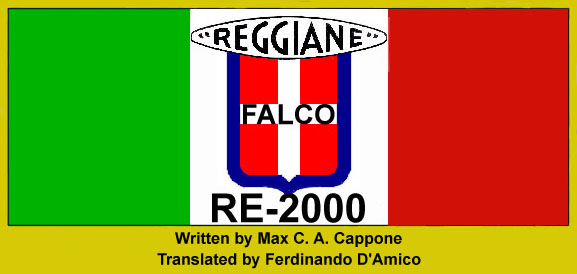


THE BEGINNING
By the end of the 1930s, the Italian aeronautical industry offered four fighters: a mixed-construction biplane with fixed undercarriage and three all-metal monoplanes with retractable undercarriage. Of the latter only one could be considered - due to its performance, technology and ease of production - of international level. Paradoxically, it was this very aircraft that would be the least employed of the three by the Regia Aeronautica, although having some success abroad. I am speaking of the Reggiane RE 2000.
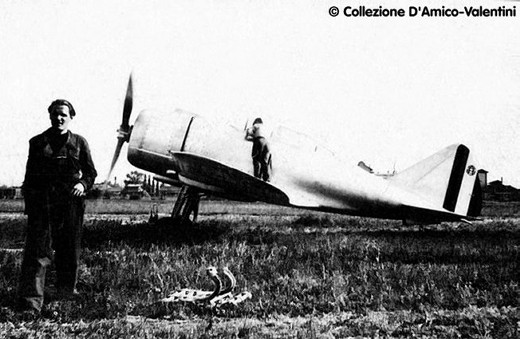
Reggiane's RE 2000 certainly deserved more luck at home; insofar the first creation of the Emilian Aviation factories certainly was one of the most interesting and capable aircraft built in Italy at the time. The aircraft was realized on the basis of the project defined by the team led by Ing. Longhi. The inspiration of the project clearly was an American one. The RE 2000 didn't hide its origins coming from the Seversky P-35, a fact caused by the previous professional experience of Ing. Longhi with the Uppercu Burnelli Aircraft Corporation, a division of the Uppercu Cadillac Corporation. The technical solutions adopted by the Italian team were, for the Italian experience of the time, clearly revolutionary ones and these required a deep as well as fast update of the technological level of the Reggiane factory and at the same time a sudden rise of professionalism in the Italian workers. It is necessary to realize that, until then, the Reggiane had only built the three-engine bomber S 79 under license and that its only home-made projects (the P 32 Bis and the Ca 405) although interesting, came directly from the old, classical, lines of thought of the "Italian school", where the experience on wooden structures still had a deep influence on the designers.
For the first time instead, special aluminum panels appeared and this requested the importation of adequate machinery and tools; the NACA profiles saw widespread use and a particular care was put into defining aerodynamic details, so much that the RE 2000 was the only plane of the so-called "Serie 0" (Fiat G.50 - Macchi C.200 - RE 2000) to be devoid from the start of any "autorotation" stall phenomenon, which were an infamous characteristic of the other two fighters.
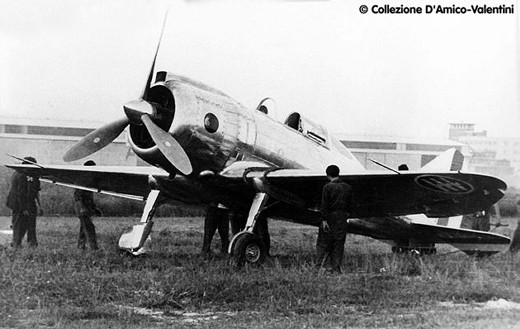
Shortly after its rollout, the prototype of the Reggiane RE 2000 (MM.408) took off for the first time from Reggio Emilia on 24 May 1939, flown by the exceptional test pilot Mario De Bernardi. The flight characteristics and the handling of the new fighter were excellent right from the start and this was confirmed during the military comparison test effected in Guidonia flown by Regia Aeronautica test pilots. The results of the comparative mock-up dogfights were even more surprising: The RE 2000 turned out to be more manoeuvrable of the Fiat Cr.42 and it was the clear winner even against the German Bf 109E!
It was thus no less surprising that the aircraft was rejected by the Regia Aeronautica, on the basis that the internal wing fuel tanks were too vulnerable and were not of the self-sealing type.
Considering that this solution guaranteed exceptional range and that the modification would have been a simple one, the motives clearly appear to have been political or of "industrial opportunity". To be fair however, we must acknowledge that the RE 2000 had at least one defect: Its Piaggio P.IX engine which was highly unreliable.
THE FALCO MIGRATES
It did not take very long before new Reggiane fighter raised much interest in several countries but, for several easily understandable reasons, such an interest managed to materialize into real contracts and supplies with Sweden and Hungary. When the U.S. retained 60 of the Seversky EP-106 Contracted to Sweden (modified P-35), the Swedish Government purchased a like number of RE-2000 fighters from Reggiane.
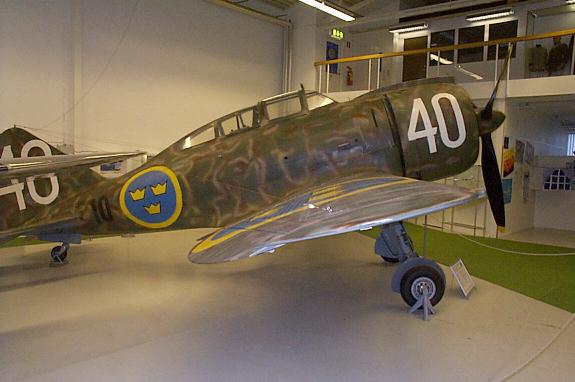
When Sweden bought its 60 RE 2000s, they were designated as the "J-20" following their numeration standards (KSF Serial Numbers 2301-2360). They were employed up to 1945, when the last J-20 was retired from service. Generally, the opinion of the Swedish pilots was rather positive and the only complaints were about the engine.
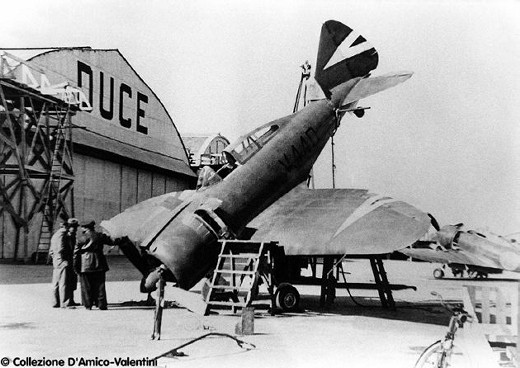
Hungary was a different case, because the RE 2000 (renamed "Héja" - Falcon) was used operationally and with good results. By the way, the internal wing fuel tanks never caused any problem. The plane, all 70 examples of which, were built in Italy (MKHL Serial Numbers V-401 - V-470) was considered so satisfactory than the MAVAG, having bought the rights for license production, and manufactured a little less than 200 examples. These, named "Héja II" but known also as "Héja M", were engined with the MW 14B, a locally built version of the Gnome Rhone K14.
"INTERCETTORE", "BIS" AND "GRANDE AUTONOMIA": OPERATIONAL WITH REGIA AERONAUTICA
Turning to the operational service of the RE 2000 with the Regia Aeronautica, it is worth remembering that only in 1941 it was decided to organize a unit to test operationally the plane. Speaking of an "unit" maybe excessive, because the planes involved were only five to which also the prototype was added. They formed the "Sezione Sperimentale Reggiane", within 74a Squadriglia (23° Gr., 3° St. C.T.) based in Sicily. The Sezione, led by Cap. Calistri, and as disbanded on August 1941. From it was born the 377a Sq., still within 23° Gr. C.T.
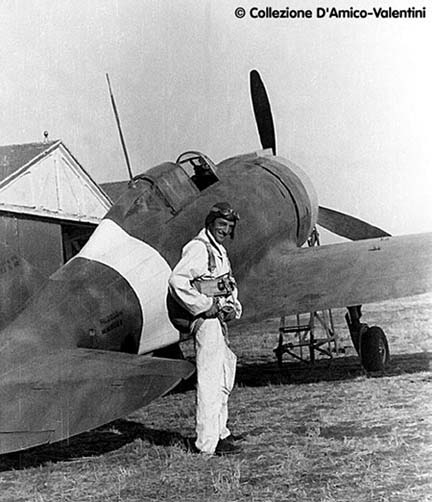
On August 1941 the new unit had nine RE 2000s available of the "Bis" version, an evolution of the project, equipped with the Piaggio P. IX Bis engine. The operations of the 377a Sq. consisted mainly of convoy escorts, thanks to the great range of the plane, but also other duties were made, like protection cruises and reconnaissance flights in search of enemy ships. Meanwhile the first RE 2000s of the Grande Autonomia (GA) version were starting to arrive at the unit. This version was different from the previous ones in having an extra fuel tank in the fuselage, improving the already great range, and by replacing the rear cockpit windows with an all-metal "hump" shaped to improve rear vision. Also adopted was the P.IX Bis engine.
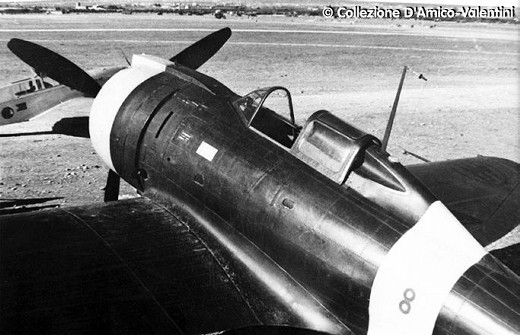
A simple truth is that the GA version was born from a late acknowledgement of the RE 2000 capabilities, that could have solved an apparently impossible problem: The in-fight transfer of fighters towards the Regia Aeronautica units of the Italian Eastern Africa territories. Unfortunately, the plane came too late, but it was decided to it put into action all the same. Only twelve examples of the GA version were made. Though, some of them were modified from the "bis" version.
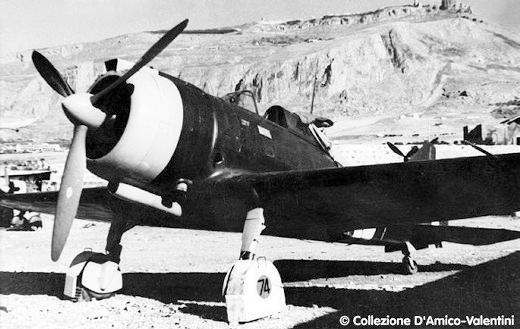
All operational service of the RE 2000 in the Regia Aeronautica ended on
September 1942, when the surviving examples were moved to the 1° Nucleo
Addestramento Intercettori in Treviso, leaving behind them an
unimpressive record consisting only in a Blenheim claimed shot down,
some successful night missions dropping frags over Malta airfields, and
the sighting of an enemy ship formation off La Galite (Tunisia), leading
to a successful action of the Italian air forces.
The lack of a great success cannot be attributed to the plane, however; the number of RE 2000s employed was very few and their first operational bases were very far from the production centers. This made it impossible to quickly solve the first maintenance problems and led also to the lack of replacement parts. As a consequence, only a few aircraft were available at any time.
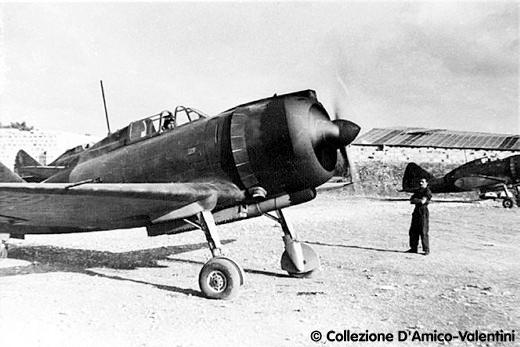
One of the more controversial aspects of the RE 2000 was thus linked to the late acknowledgement of its possibilities. Having been refused as a first line fighter when it would have been one of the best choices, it was accepted after it had become obsolete.
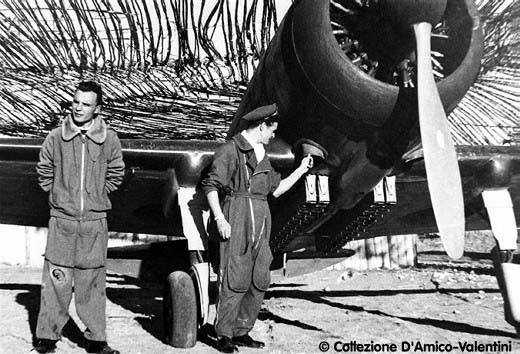
THE "CATAPULTABILE" AND THE REGIA MARINA
As a further proof of its capabilities, the Regia Marina (Italian Royal Navy), having the need of replacing the old Ro 43 biplane as a ship-board catapult fighter, and after examining several options, selected the RE 2000, which was developed in a special version to be launched by catapult. In reality, with this choice the Navy had overcome the obsolete concept of a twin-place seaplane launched by catapult and having reconnaissance and observation tasks, pushing the envelope to include aerial defence against enemy planes. This wasn't a new concept, as it had already been applied by the British Royal Navy with the CAM ships (utilizing Hawker Hurricanes), but was a true novelty of the Italian Navy.
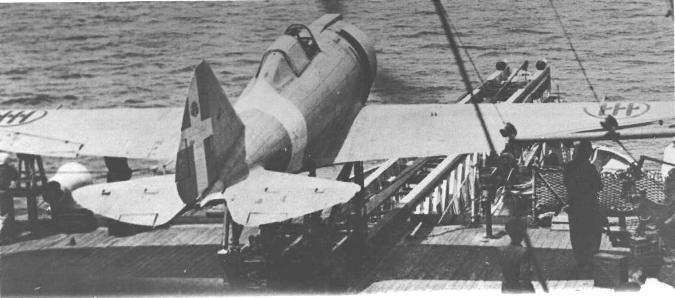
According to the foreseen operational scheme, the RE 2000, once having
completed its task, and thanks to its great range should head towards
the nearest land base. Then, with a special trailer, it would have been
transported to the Naval base to be re-embarked on its ship.
It was necessary to realize an appropriate catapult that could solve the
problem of the necessary acceleration to launch the aircraft.
This acceleration in itself was another problem because, due to the type
of plane, it needed to be fairly high, thus presenting some physical
difficulties for the pilot. The problem was finally solved, obtaining a
steady acceleration that was capable of letting the plane reach the
required speed at the end of the run.
Primary modifications included the applications of the attachment points
for the catapult, but also, the instruments were modified and it was
adopted the same rear cockpit "hump" as on the GA version.
The first prototype (MM 471) was delivered from Reggiane on 21 May 1941 and it was meant to be flown to Grottaglie, in order to be then transported by route to Taranto. However, the plane flown by Cap. Giovanni Fabbri crashed near Gubbio for unknown reasons, killing its pilot and being completely destroyed. In the meantime a second RE 2000 modified as "Catapultabile" was ready to be delivered. This second prototype (MM 485) managed to reach Taranto but, during the attempts to load it on the ship, it sustained damage that prevented the continuation of the tests.
Thus, a Swedish contract J-20 was hurriedly modified, so that, on 14 July 1941, Ten . Giulio Reiner (who had replaced the unlucky Cap. Fabbri as the test pilot) managed to bring the modified plane (MM 8281) to Grottaglie.
Meanwhile, on 12 July the tests for the catapult launch had been already started at Taranto, using a shaped metal container of the same weight as the actual airplane. During these tests, which continued until March 1942, several technical problems were discovered and solved, while trying to complete the launch procedures.
On 12 March the third "Catapultabile" was brought from Grottaglie from Taranto to be embarked on the same day on one of the Battleships of the Italian Navy. The beginning of the tests was planned for March 15, but it was delayed because of adverse weather.
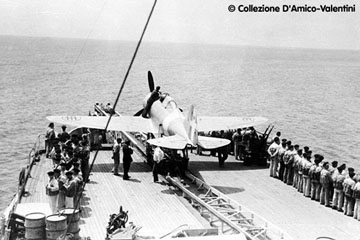
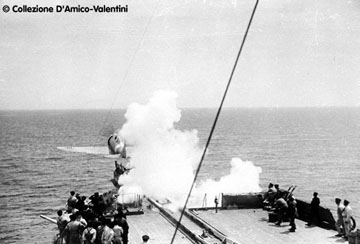
Several serious problems with the structure of the catapult on the battleship led to another suspension of the test. At that point it was decided to continue with the evaluation aboard the RN Miraglia, stating also the date for the final attempt: May 9, 1942. Finally, on the established day, the RE 2000 "Catapultabile", flown by Ten. Reiner was "shot" from the catapult, which then concluded the testing cycle with very good results.
Ten RE 2000 "Catapultabile" were supplied to the Squadriglia di Riserva Aerea delle FF.NN.BB (Flying Reserve Squadriglia of the Naval Battle Forces), led by Cap. Donato Tondi - who had pushed the whole RE 2000 ship-board project - based first at Grottaglie, then at Capodichino, and finally at La Spezia. The Squadriglia had the task of training the pilots to the launch procedures and, using also Macchi C.200, Fiat G.50 and Cr.42, also effecting the aerial defence of the naval bases.
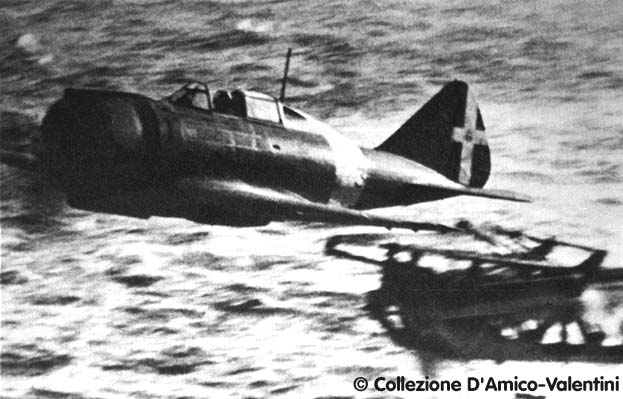
In April 1943 the Squadriglia was dissolved and was formed the 1° Gr. Riserva Aerea of the FF.NN.BB., led by Tondi promoted to Maggiore. The Gruppo was formed by three Squadriglie: 1a Sq. based at Sarzana, 2a Sq. based at Grottaglie, and 3a Sq. based at La Spezia. Traces of the last two surviving RE 2000 Cat. assigned to the Gruppo were lost after the Armistice. As far as it concerns the embarked aircraft, in the Summer of 1943 two RE 2000 were on the battleship RN Roma, two on RN Vittorio Veneto and one on RN Littorio (later RN Italia).
The Armistice saw the Italian Fleet leaving La Spezia (according to the Armistice Clauses) with a RE 2000 aboard the "Roma" (was sunk with it), one aboard the "Italia" (was damaged during the German attack and later dropped over board) and two aboard "Vittorio Veneto". One of the latter was launched during the German attack and took part to the search for the survivors of the battleship "Roma".
At the end of the search he attempted to land on Ajaccio airfield and crashed while landing. The last of the two planes aboard "Vittorio Veneto" (or, more correctly, parts of it) succeeded in surviving through several adventures until today, and these are the only remnants of any RE 2000 in Italy.
Therefore the fate of the last RE 2000 is lost in the shadow of the Armistice. Six of them appear in the German inventory of requisitioned Italian aircraft, but it is doubtful that remaining RE 2000s would have been in operational condition. Most probably they had been scrapped or utilized as dummies (decoys) on northern Italian airfields.
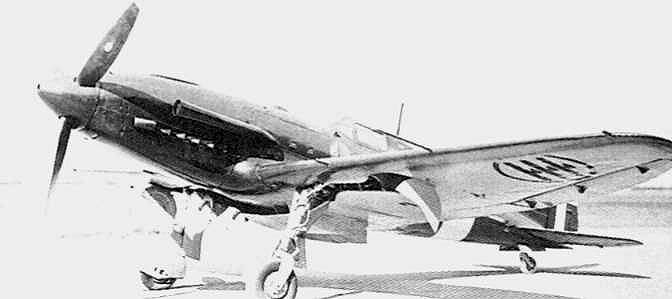
Nevertheless the Falco's descendent, in spite of such a discouraging beginning, will almost achieve the perfection with the RE 2005 Sagittario. The P-35 Darwinism gave origin to two different evolution lines: the big radial engined P-47 and the slender in line engined RE 2005, both of them at the top of the best fighters of WW 2, but that is another story.
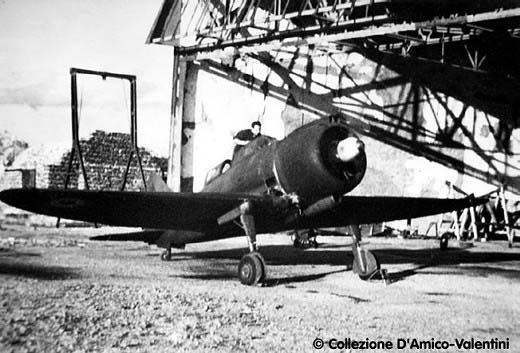
TECHNICAL DATA
Role: Single-seat fighter and fighter bomber
Engine: 1 x Piaggio P.IX RC 40 radial engine; 1000 hp
Bis, GA and Cat.: 1 x Piaggio P.IX Bis RC 40; 1000 hp
Length: 26,21 ft
Height: 10.49 ft
Wing span: 36,08 ft
Wing area: 219,58 sq/ft
Empty weight: 5573 lbs
GA: 5867 lbs
Cat.: 5894 lbs
Useful Load: 2009 lbs
GA: 2599 lbs
Cat.: 2063 lbs
Loaded weight: 7606 lbs
GA: 8466 lbs
Cat.: 7957 lbs
Max. Speed: 329 mph at 17,388 ft.
GA and Cat.: 323 mph
Service ceiling: 36754 ft.
GA and Cat.: 32808 ft
Range (at 19,685 ft and 267 mph):
GA: 1243 miles
Cat.: 802 miles
Climb to 19,685 ft: 6'10"
GA and Cat.: 7'45"
Armament:
2 x 12,7mm Breda SAFAT MG with 300 rounds each. The "Intercettore",
"Bis" and "GA" versions had the possibility to attach a "Spezzoniera
Automatica Nardi" under the fuselage, consisting of two launchers each
composed of two lines of twenty-two 2 kilos frag-bombs, for a total of
88 frag-bombs.
Crew: 1
In Service: 1941
Countries in Service: Italy, Hungary & Sweden
Aircraft built: 158 (28 for RA - 70 for Hungary - 60 for Sweden)
RA SERIAL NUMBERS
Prototypes
MM 408 (Intercettore) then upgraded to operational standard and
registered with new serial MM 5074, MM 471 and MM 485 (Catapultabile)
Operational production
Intercettore
MM 5068 - 5072 (5)
Grande Autonomia
MM 8059 - 8070 (12). Some of them are Intercettores upgraded to Bis
version and then to GA standard. Very little is known about Bis version;
it is also possible that such a version is a transition between
Intercettore and GA. We can also consider the possibility that some of
the 12 GA built were born as Bis to be upgraded then at GA standard
Catapultabile
MM 8281 - MM 8288 (8)
GLOSSARY
Cat.: Catapultabile (Catapult Launch)
C.T.: Caccia Terrestre (Ground based Fighter)
F: Flygflottilj (KSF great based on 2 - 4 Flygdivisionen)
Flygdivisionen: KSF great based on about 18 aircraft
GA: Grande Autonomia (Long Range)
Gr.: Gruppo (RA Unit formed by 2 or 3 Squadriglie)
Intercettore: Interceptor
KSF: Kunglika Svenska Flygvapnet (Swedish Royal Air Force)
MÁVAG: Magyar Állami Vagon-és Gépgyár (State Hungarian Railroad Factory)
MKHL: Magyar Királyi Honvéd Légierö (Royal Hungarian Air Force)
MM: Matricola Militare (Military Serial)
RA: Regia Aeronautica (Royal Italian Air Force)
RM: Regia Marina (Royal Italian Navy)
RN: Regia Nave (His Majesty Ship)
SAFAT: Societŕ Anonima Fabbrica Armi Torino (Turin Weapon Factory Ltd)
Sezione: part of the Squadriglia. Usually on 3 aircraft
Sq.: Squadriglia (RA Unit formed by an average of 6 - 10 aircraft subdivided in Sezioni)
St.: Stormo (RA great Unit formed by 2 or 3 Gruppi)
BIBLIOGRAPHY AND SOURCES
Alegy, Gregory - Gli altri Reggiane: Reggiane RE 2000 Relazione
preliminare - Ali Antiche n. 24 Gennaio-Febbraio 1992 - GAVS - Roma 1992
Alonzo, Francesco Saverio - Il museo aeronautico svedese - Storia
Militare n. 76 Gennaio 2000 - Albertelli Edizioni Speciali - Parma 2000
Arena, Nino - I caccia a motore radiale: la generazione intermedia - STEM Mucchi - Modena 1979
Arena, Nino - I caccia a motore radiale: FIAT G 50 - STEM Mucchi - Modena 1979
Arena, Nino - I caccia a motore radiale: Macchi MC.200 - STEM Mucchi - Modena 1979
Arena, Nino - I caccia a motore radiale: Reggiane RE. 2000 - STEM Mucchi - Modena 1979
Arena, Nino - La Regia Aeronautica 1939-1943 - Ufficio Storico Stato Maggiore Aeronautica - Roma 1981
Brotzu, Emilio - Caso, Michele - Cosolo, Gherardo - Dimensione Cielo, caccia assalto vol. 1-2 - Edizioni Bizzarri 1972
Caruana, Richard J. - The Reggiane Re.2000 - Malta Flypast nr 2
Caruana, Richard J. - Reggiane's export fighter - Scale Aviation Modeller International
Cattaneo, Gianni - "Caproni" and reindeers, aircraft sales promotion in
Sweden in 1940-1943 - Aerofan n. 67 Ottobre-Dicembre 1998 - GAE - Milano
1998
Cattaneo, Gianni - AerMacchi C. 200 - La Bancarella Aeronautica - Torino 1997
Cattaneo, Gianni - The Reggiane Re.2000 - Profile Publications nr 123 - Leatherhead (UK) 1966
Cupido, Joe - Seversky e l'AT-12 - Aerei n. 2 Febbraio 2000 - Delta Editrice - Parma 2000
Davies, Larry - P-35 - Mini nr. 1 - Squadron/Signal Publication - Carrollton TX 1994
De Prato, Tullio - Un pilota contadino - Mucchi Editore - Modena 1985
De Marchi, Italo - Tonizzo, Pietro - Macchi MC. 200 "Saetta" - FIAT CR. 32 - Mucchi Editore - Modena 1994
Emiliani, Angelo - Ghergo, Giuseppe - Vigna, Achille - Regia Aeronautica: colori e insegne - Intergest - Milano 1974
Emiliani, Angelo - Ghergo, Giuseppe - Vigna, Achille - Regia
Aeronautica: periodo prebellico e fronti occidentali - Intergest -
Milano 1975
Govi, Sergio - Il caccia RE 2000 e la storia delle "Reggiane" - GAE - Milano 1983
Govi, Sergio - I Reggiane dalla A alla Z - GAE - Milano 1985
Govi, Sergio - Fotoalbum "Reggiane" - GAE - Milano 1986
Gueli, Marco - D'Amico, Ferdinando - Rovere, Riccardo - Guida agli aerei
storici italiani - Edizioni dell'Ateneo & Bizzarri - Roma 1978
Lazzati, Giulio - Stormi d'Italia: Storia dell'Aviazione Militare Italiana - Mursia - Milano 1975
Longhi, Roberto - Reggiane and I … … a fighter designer recalls - Air Enthusiast Quarterly nr 2 – 1976
Malizia, Nicola - L'armamento dei velivoli della Regia Aeronautica -
Storia Militare n. 42 Marzo 1997 - Albertelli Edizioni Speciali - Parma
1997
Malizia, Nicola - Le bombe speciali della Regia Aeronautica - Storia
Militare n. 44 Marzo 1997 - Albertelli Edizioni Speciali - Parma 1997
Malizia, Nicola - Le armi degli aerei italiani - Storia Militare n. 48
Settembre 1997 - Albertelli Edizioni Speciali - Parma 1997
Marcon, Tullio - I velivoli catapultabili in guerra: 1939-1945 - Storia
Militare n. 9 Giugno 1994 - Albertelli Edizioni Speciali - Parma 1994
Marcon, Tullio - I RE. 2000 imbarcati nel settembre 1943 - Storia
Militare n. 68 Maggio 1999 - Albertelli Edizioni Speciali - Parma 1999
Marcon, Tullio - Malta: difesa ad oltranza sinonimo di vittoria - Storia
Militare n. 46-47 Luglio-Agosto 1997 - Albertelli Edizioni Speciali -
Parma 1997
Massimello, Giovanni - Su Malta col RE.2000 - Storia Militare n. 63 Dicembre 1998 - Albertelli Edizioni Speciali - Parma 1998
Neulen Hans Werner - Il ricco bottino - GAE - Milano 2000
Postiglio, Umberto - Degl'Innocenti, Andrea - Colori e schemi mimetici
della Regia Aeronautica 1935-1943 - GMT/CMPR/GAVS - Trento 1997
Reiner, Giulio - RE 2000 Catapultabile, la storia dei collaudi - Aerofan n. 2/80 Aprile-Giugno 1980 - AISA/GAE - Parma 1980
Sgarlato, Nico - Aerei italiani in Ungheria: le forniture durante gli
anni Trenta e Quaranta - Aerei nella Storia n. 11 Aprile-Maggio 2000 -
Delta Editrice - Parma 2000
Sgarlato, Nico - Caccia e bombardieri della Regia Aeronautica - Delta Editrice - Parma 1995
Sárhidai Gyula, Punka György, Kozlik Viktor – Hungarian Eagles : A
Magyar Királyi Honvéd Légierö 1920-1945 – Hikoki Publications –
Haldershot, Hants GB 1996
Stridsberg, Sven - J 20 Ett av vĺra italienska jaktplan - SFF - Stockholm (S) 1993
Tonizzo, Pietro - FIAT G.50 Freccia - Mucchi editore - Modena 1994
Vergnano, Piero - FIAT G 50 - La Bancarella Aeronautica - Torino 1997
KSF - Flygplan typ J 20 beskrivning 1942 - Victor Pettersons Bokindustriaktiebolag - Stockholm (S) 1943

